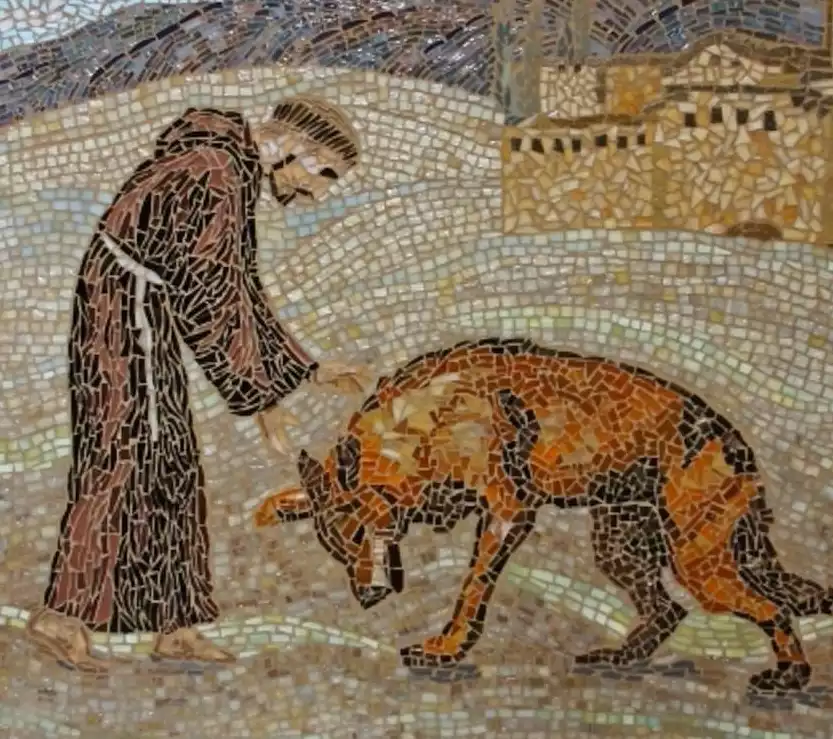
Saint Francis of Assisi, born in 1181 and passing in 1226, epitomized a life of harmony with nature and exemplified boundless compassion. His legendary encounter with the wolf of Gubbio stands as a testament to his extraordinary ability to bridge the chasm between man and beast, fear and trust. This narrative, more than a mere tale, serves as a profound allegory, symbolizing the potential for peace and understanding in the face of adversity. It underscores the transformative power of empathy and the timeless teachings of Saint Francis, resonating with virtues of kindness and reconciliation.
Shadows Over Gubbio
In the verdant valleys of Umbria, the medieval town of Gubbio thrived, its cobbled streets and stone houses a testament to the resilience and artistry of its people. Yet, beneath the veneer of prosperity and peace, a palpable tension gripped the air. Whispers of a lurking menace cast a shadow over the town, as tales of a fearsome wolf spread like wildfire. The creature, it was said, roamed the outskirts of Gubbio, its howls piercing the tranquility of the night, its presence a constant reminder of the fragile boundary between civilization and the wild unknown.
The wolf of Gubbio was no ordinary beast. Its eyes, gleaming with an almost spectral intensity, held a depth that seemed to transcend the natural world. Livestock vanished without a trace, and the townsfolk, once bound by a spirit of community and togetherness, found themselves ensnared in a web of suspicion and dread. The fields lay fallow, as farmers hesitated to venture beyond the safety of their walls, and the once-bustling marketplaces grew silent, the shadow of the wolf looming ever larger in the collective psyche of Gubbio.
Amidst this climate of fear, a collective resolve began to emerge. Meetings were held under the cover of night, voices hushed yet urgent, as the people of Gubbio sought a solution to the plight that besieged them. Strategies were devised, traps were laid, yet the wolf, as if guided by a cunning and elusive spirit, evaded every attempt to capture or slay it. The creature, it seemed, was not merely a physical adversary but a challenge to the very heart and soul of Gubbio, a riddle wrapped in the enigma of the untamed wilderness.
It was in these dire times that the name of Saint Francis of Assisi began to be uttered in hushed tones, a beacon of hope in the encroaching darkness. Known far and wide for his profound connection with all of God’s creation, Saint Francis represented a different path, one not of confrontation but of understanding and harmony. His teachings, imbued with the essence of compassion and kinship with nature, resonated with a town besieged by fear, offering a glimmer of light in the shadow of the wolf.
As the full moon cast its silver glow over the cobblestone streets of Gubbio, the stage was set for an encounter that would forever alter the course of the town’s history. The journey of Saint Francis to Gubbio was not just a pilgrimage but a mission, a testament to the enduring power of empathy and the unspoken bond that links every living creature. In the heart of the Umbrian valleys, a tale of redemption was about to unfold, a narrative woven from the threads of courage, understanding, and an unwavering belief in the possibility of a harmonious coexistence.
The Pact of Peace
The morning sun cast a gentle light over Gubbio, heralding a day unlike any before. Saint Francis, garbed in the humble robes of his faith, stepped forward, his presence a calm amidst the storm of apprehension that gripped the town. His eyes, alight with a profound sense of purpose, met those of the townsfolk, conveying a message of hope without the need for words. It was here, at the boundary where fear and courage intertwine, that Saint Francis chose to walk the path few would dare to tread—the path leading to the lair of the wolf.
The townspeople watched, breath held in collective anticipation, as Saint Francis ventured into the wilderness, his figure gradually swallowed by the embrace of the forest. Murmurs and prayers filled the air, each heart entwined with the fate of the man who dared to bridge the chasm between man and beast.
In the secluded depths of the woods, the encounter unfolded. The wolf, formidable in its stature and presence, emerged from the shadows, its gaze locked with that of Saint Francis. A hush fell over the natural world, as if time itself had paused to witness this improbable communion. Saint Francis, with a gesture of peace and an outstretched hand, beckoned the wolf closer. Words of understanding, whispered in a tone of reverence and kinship, flowed from the saint, weaving an invisible bond between human and animal.
As the wolf listened, its demeanor softened, the barriers of fear and mistrust melting away in the warmth of genuine empathy. A pact, silent but as binding as any forged by words, was formed in that sacred clearing—a pact of peace, promising a new dawn for Gubbio and its inhabitants.
The tale of Saint Francis and the wolf of Gubbio endures as a parable of reconciliation and understanding. It serves as a profound reminder of the harmony attainable when compassion guides our actions, forever enshrining Saint Francis’s legacy as a bridge between worlds, human and divine.
References
Bonaventure, Saint. The Life of St. Francis of Assisi. HarperOne, 2005.
Englebert, Omer. The Lives of the Saints. Barnes & Noble Books, 1994.
Voragine, Jacobus de. The Golden Legend: Readings on the Saints. Princeton University Press, 1995.
